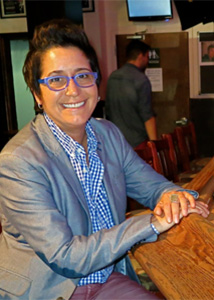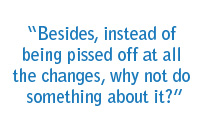 Lisa Cannistraci is the owner of the bar Henrietta Hudson at the corner of Morton and Hudson Streets and is also vice-president of Marriage Equality USA’s Board of Directors. Lisa has combined her love of activism with her business for over two decades now, and literally lives above her bar where “the ceiling touches my floor.”
Lisa Cannistraci is the owner of the bar Henrietta Hudson at the corner of Morton and Hudson Streets and is also vice-president of Marriage Equality USA’s Board of Directors. Lisa has combined her love of activism with her business for over two decades now, and literally lives above her bar where “the ceiling touches my floor.”
While growing up in Park Slope in the 60s, Lisa Cannistraci was attracted to activism at an early age. “My first foray into an election was when I was in 2nd grade,” she recalls. “We had to pick a candidate for mayor and campaign for them. I picked John Lindsay and I went out at seven years old, talking to everybody. He won and I loved it! The civil rights movement really had a big impact on me as well.”
In 1985 Cannistraci started tending bar at the Cubbyhole and, when it closed, moved on to Kelly’s Village West. “I was a bartender with a big following,” she says. “At Kelly’s I started doing a women’s night on Sunday and it escalated into a huge event. One night, Minnie Rivera came in. Minnie was a veteran in the gay women’s nightlife scene who owned a number of bars. She was an entrepreneur who saw something in me; how I was working the crowds and the room. She approached me to become her partner in reopening a new space in the old Cubbyhole. We named it Henrietta Hudson and opened on Halloween in 1991. Now we currently hold the record for being the longest consecutive running lesbian bar in the country.”
Ironically, Cannistraci has found that as the gay rights movement moves forward, it’s hurt her business a little. “I hate to say it,” she admits. “But as people become more comfortable being out in the world, they have less of a reason to go to a lesbian venue.” Yet Cannistraci plans to stay open “forever,” “I mean that,” she vows. “The bar is my passion and my love. What I love about it is that it’s not only a business, but it’s a business with a conscience. I can use Henrietta Hudson as a platform to reach out and do all the activism that I crave.”
This activism really caught fire in 1992 when she helped launch “New York Boycott Colorado” after that state passed Amendment 2 and continues up to her current position with Marriage Equality USA. And while it’s still a fight, things have gotten better. “In 1993, when we held the March on Washington, it was such a struggle to get our agenda across,” she says. “But when I recently went to the Supreme Court as they were listening to the marriage equality arguments, we had the two best attorneys in the country advocating for us. From 1993 to 2013, it’s such a different feeling about gay rights and marriage equality.” What does she personally get from advocacy? “It’s a beautiful feeling,” she replies. “And you don’t do it for that reason because you don’t know what you’re going to feel. But it fills me up. It really does.”
When Cannistraci started working in the West Village there wasn’t even a street light on the corner of Hudson and Morton. “There were no stop signs either,” she says. “It was desolate. I could stand behind the bar for hours and not see anyone walk by. We were literally a destination location. And when I opened Henrietta’s 20 years ago the Morton Street block association didn’t want a lesbian bar. Now I’m on the community board and on the social services committee, helping local kids. It’s so different now!”
 Cannistraci is grateful to have landed in the West Village as both a business owner and a resident. “I feel really, really lucky to live here because it’s my favorite place in the world,” she says. “I’ve traveled extensively and there’s nothing like it.” According to her, this feeling is all the more reason to embrace change. “I don’t really see the merit in not being a part of change. A lot of people have this grudge about the new people who are moving into the West Village. In my experience, though, they seem to be very invested in the community and they seem to care. Besides, instead of being pissed off at all the changes, why not do something about it? Things aren’t going back to the way they were. Instead, let’s put some energy into maintaining the waterfront, or plant trees, or raise money for a cause. Let’s do something else to enhance the neighborhood and to make it ours.”
Cannistraci is grateful to have landed in the West Village as both a business owner and a resident. “I feel really, really lucky to live here because it’s my favorite place in the world,” she says. “I’ve traveled extensively and there’s nothing like it.” According to her, this feeling is all the more reason to embrace change. “I don’t really see the merit in not being a part of change. A lot of people have this grudge about the new people who are moving into the West Village. In my experience, though, they seem to be very invested in the community and they seem to care. Besides, instead of being pissed off at all the changes, why not do something about it? Things aren’t going back to the way they were. Instead, let’s put some energy into maintaining the waterfront, or plant trees, or raise money for a cause. Let’s do something else to enhance the neighborhood and to make it ours.”
Photo: Maggie Berkvist
